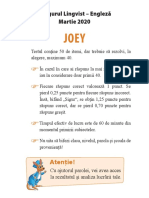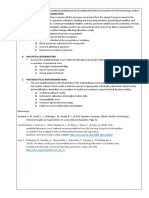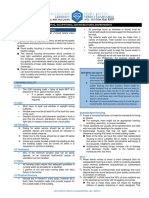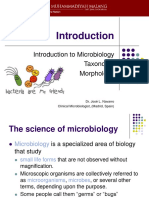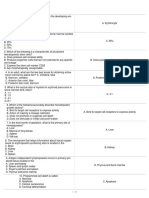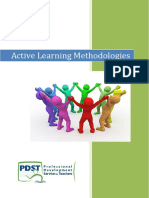MT114 - Hematology I
MT114 - Hematology I
Uploaded by
97bn4symtkCopyright:
Available Formats
MT114 - Hematology I
MT114 - Hematology I
Uploaded by
97bn4symtkOriginal Description:
Original Title
Copyright
Available Formats
Share this document
Did you find this document useful?
Is this content inappropriate?
Copyright:
Available Formats
MT114 - Hematology I
MT114 - Hematology I
Uploaded by
97bn4symtkCopyright:
Available Formats
NORTHWESTERN UNIVERSITY
Don Mariano Marcos Avenue, Laoag City, 2900, Ilocos Norte, Philippines
TEACHING SYLLABUS ACA-F 0801E
COLLEGE OF ALLIED HEALTH SCIENCES
Department of Medical Technology
First Semester, AY 2023-2024
Course Title : Hematology I
Course Code : MT114
VISION : Northwestern University envisions itself to be a premier institution of learning in Asia committed to excellence and
ethical formation of global relevance.
MISSION : Northwestern University is dedicated to develop individuals to become highly competent, socially responsible and
ethically upright leaders.
INSTITUTIONAL OBJECTIVES : Concomitant to its role as a university in which higher learning, research, and community extension are developed
and nurtured, Northwestern University adopts the following objectives where excellence as a way of life is its rallying
point.
1. To provide a strong educational foundation by offering and maintaining comprehensive basic/general education
programs and strengthening pillars of knowledge in the academy in order to produce functional graduates who
will be able to meet the needs of both local and global markets.
2. To mold and prepare students and employees for responsible leadership and effective citizenship, and to be
socially responsible through the inculcation of the ideals of democracy and positive values in all aspects of their
life
3. To provide a strong and comprehensive training and development programs for students’ professional growth and
Issue Status: 4 Revision: 3 Date: 2 2 A u g u s t 2 0 2 3 Approved by: President Page 1 of 20
NORTHWESTERN UNIVERSITY
Don Mariano Marcos Avenue, Laoag City, 2900, Ilocos Norte, Philippines
advancement and equip them with competitive advantage in these changing times.
4. To align and harmonize the research and extension programs with the local, regional, national and global thrusts.
5. To explore and expand linkages with local and international agencies.
NAME OF THE PROGRAM : Bachelor of Science in Medical Laboratory Science
PROGRAM OBJECTIVES : The Medical Laboratory Science Program aims to:
1. Develop the knowledge, attitudes and skills in the performance of clinical laboratory procedures needed to
help the physician in the proper diagnosis, treatment, prognosis and prevention of diseases;
2. Develop skills in critical and analytical thinking to advance knowledge in Medical Technology/Clinical
Laboratory Science and contribute to the challenges of the profession;
3. Develop leadership skills and to promote competence and excellence and;
4. Uphold moral and ethical values in the service of society and in the practice of the profession.
PROGRAM OUTCOMES : Graduates of Bachelor of Science in Medical Technology/Bachelor in Medical Laboratory Science like any other
Health Professions Education must be able to apply analytical and critical thinking in clinical laboratory. As such,
graduates abovementioned must:
a. Collect samples, prepare specimen for analysis, determine the acceptability of samples within guidelines,
perform the test according to standard methods/techniques;
b. Demonstrate skills in judgment and decision making to analyze quality control and recognize implausible
results and take appropriate actions to maintain accuracy and precision;
c. Perform accurately data gathering, processing and encoding into the computer system;
d. Observe the principles of data security or patient confidentiality, maintain ethical standards in working with
other laboratory and hospital personnel;
Issue Status: 4 Revision: 3 Date: 2 2 A u g u s t 2 0 2 3 Approved by: President Page 2 of 20
NORTHWESTERN UNIVERSITY
Don Mariano Marcos Avenue, Laoag City, 2900, Ilocos Norte, Philippines
e. Possess good communication and human relation skills for effective and healthy interaction with health care
professionals;
f. Take responsibility for their own professional development or continuing education especially computer
education in the application and management of data and computerized laboratory equipment; and,
g. Acquire basic management, supervision, administrative skills to contribute to the resolution of conflicts
pertaining to laboratory management, implementation of changes in response to technology and laboratory
procedures, development of safety management procedures and improvement of standards of practice.
I. COURSE INFORMATION
COURSE CODE PRE-REQUISITE/S CO-REQUISITE/S:
COURSE DESCRIPTIVE ANA 101: Human
TITLE Hematology I MT 114 Anatomy and
None
Physiology with
Pathophysiology
LABORATORY
LECTURE HOURS
COURSE CREDIT 4 units 3 hours CONTACT HOURS 3 hours
PER WEEK
PER WEEK
This course deals with the study of fundamentals of blood as a tissue. It includes blood cell disorders, special hematology evaluation,
COURSE DESCRIPTION
quality control and quality assurance.
COURSE OUTCOMES After finishing the course, the students should be able to:
1. Discuss, reflect and internalize the mission, vision and objectives of the university, college and department and to discuss and
internalize the objectives of ISO and CHAMPS;
2. Explain the facts and principles of hematological determination which will aid the physician in the diagnosis and treatment of
blood diseases and other diseases affecting blood indirectly.
Issue Status: 4 Revision: 3 Date: 2 2 A u g u s t 2 0 2 3 Approved by: President Page 3 of 20
NORTHWESTERN UNIVERSITY
Don Mariano Marcos Avenue, Laoag City, 2900, Ilocos Norte, Philippines
3. Identify microscopically the normal and abnormal blood cells.
4. Assume responsibility in handling blood specimens, including examination and interpretation.
5. Appreciate the importance of hematological tests to pathologic conditions.
6. Perform hematological tests with precision, accuracy, and reliability.
7. Manifest the following values: integrity, honestly, critical thinking, empathy, and value for life.
INSTRUCTIONAL ELECTRONIC MATERIALS: Canvas Learning Units
MATERIALS: Unit 1. Introduction to Hematology
Unit 2. Biochemical and Physiological Aspects of Blood
Unit 3. Hematology Proper
Unit 4. Blood Cell Disorders
VIDEOS: Video 1. History of Hematology
Link: https://www.youtube.com/watch?v=3VlckXrY9TU
Video 2. Blood Collection Methods
Link: https://www.youtube.com/watch?v=AI8jESrzqx0
Link: https://www.youtube.com/watch?v=WS9kWNx4gII
Video 3. The Components of Blood
Link: https://www.youtube.com/watch?v=VSVYgivfs9c
Link: https://www.youtube.com/watch?v=qrE6Y0Se8bw
Link:https://www.youtube.com/results?sp=mAEB&search_query=white+blood+cells
Video 4. Manual Blood Cell Counts
Link: https://www.youtube.com/watch?v=qVa6uewHY8w
Video 5. Erythrocyte Indices
Link: https://www.youtube.com/watch?v=QUHqYVK-Nhg
Issue Status: 4 Revision: 3 Date: 2 2 A u g u s t 2 0 2 3 Approved by: President Page 4 of 20
NORTHWESTERN UNIVERSITY
Don Mariano Marcos Avenue, Laoag City, 2900, Ilocos Norte, Philippines
Video 6. Anemia
Link: https://www.youtube.com/watch?v=IfmJeWW4OyQ
Video 7. Leukemia
Link: https://www.youtube.com/watch?v=PnueuY3PltM
POWERPOINT PRESENTATIONS: Powerpoint 1: Introduction
Powerpoint 2: Biochemical and Physiological Aspects of Blood
Powerpoint 3: Blood Collection
Powerpoint 4: Routine Hematologic Tests
Powerpoint 5: Hemoglobin-Hematocrit-Differential Count
Powerpoint 6: Cell Morphology
Powerpoint 7: Blood Indices
Powerpoint 8: Erythrocyte Sedimentation Rate
Powerpoint 9: Erythrocyte Disorders
Powerpoint 10: Leukocyte Disorders
PRINTED AND ADDITIONAL Lecture Notes in Hematology I by Aldrin C. Tumamao, RMT. MaEd
LEARNING MATERIALS: Laboratory Manual in Hematology by Sadang
FACILITY & A. Classroom Requirements
EQUIPMENT For regular classroom instruction, the class shall have a minimum of 20 and maximum of 40 students. The classroom area shall
have at least 7 meters x 9 meters or 63 square meters.
1. All students should be sage and comfortably seated.
2. The ventilation and temperature for the entire room should be conducive for learning and instruction.
3. The audiovisual facilities should be properly situated to ensure clear presentation visible form all areas of the classroom.
B. Laboratory Classrooms
Issue Status: 4 Revision: 3 Date: 2 2 A u g u s t 2 0 2 3 Approved by: President Page 5 of 20
NORTHWESTERN UNIVERSITY
Don Mariano Marcos Avenue, Laoag City, 2900, Ilocos Norte, Philippines
Laboratory classroom must accommodate maximum of twenty (20) students.
1. At least one (1) fire extinguisher placed outside the door in each laboratory. The fire extinguisher must have a record of refill
and expiry date attached to the unit.
2. At least two (2) doors which will serve as an entrance and exit.
3. Laboratory rooms shall be adequately equipped with available safety and emergency care facilities
GRADING: 1. Transparency in the grading system keeps the instructors and the students accountable and aware of where they stand. It
exudes trustworthiness, which plays a vital role in nurturing good school relations and raising students’ achievement. Hence,
this should be discussed during the class orientation.
2. To conform to Outcomes-Based Education, students’ learning would be assessed using these two criteria: Major
Examinations (40%) and Class Standing (60%). For lecture and laboratory subjects, Written Works include but are not
limited to long examinations (Preliminary, Midterm, and Final Examinations) while Performance Tasks in lecture include but
are not limited to quizzes, performance/products/outputs, class participation/attendance, oral reporting, demonstrations, etc.
Performance tasks in Laboratory would include laboratory activities, face to face and written.
MAJOR EXAMINATIONS (40%) CLASS STANDING (60%)
Prelim Examination Lecture:
Midterm Examination Quizzes = 70%
Endterm Examination Class Participation = 15%
Attendance = 15%
Laboratory:
Skills evaluation = 70%
Class Participation = 15%
Attendance = 15%
Grades will therefore be calculated as follows:
Preliminary Grade = 0.4 (Combined Major Examination + 0.6 (Combined Class Standing)
Issue Status: 4 Revision: 3 Date: 2 2 A u g u s t 2 0 2 3 Approved by: President Page 6 of 20
NORTHWESTERN UNIVERSITY
Don Mariano Marcos Avenue, Laoag City, 2900, Ilocos Norte, Philippines
Midterm Grade = 0.4 (Combined Major Examination + 0.6 (Combined Class Standing)
End term Grade = 0.4 (Combined Major Examination + 0.6 (Combined Class Standing)
Final Grade = (Prelim Grade + Midterm Grade + End term Grade)/3
3. A faculty member can file a grade of Incomplete (INC) only for students that have satisfactory class standing but with the
following deficiencies: (1) an excusable absence for a major examination (lack of examination) and Finals Permit; (2) failure to
submit a course requirement as indicated in the syllabus. Compliance to the mentioned course requirements should be done by
the students one year after the INC grade has been filed at the Registrar’s Office. Failure to comply within the given period
means the student has to retake the course.
Note: Class Standing includes any/all of the following:
Recitation, quizzes/test, homework, seatwork, laboratory exercises, class reports, projects, etc.
Course Outcomes (COs) and Relationship to Program Outcomes
Course Outcomes Program Outcomes
After finishing the course, the student must be able to: a b c d e f g
1.Recite and discuss the IPVMO and Core Values of the University, VMO of
the college, Program Educational Objectives and Outcomes, and University I I I I E I D
policies.
2.Explain the facts and principles of hematological determination which will
aid the physician in the diagnosis and treatment of blood diseases and other D D D D D D D
diseases affecting blood indirectly.
Issue Status: 4 Revision: 3 Date: 2 2 A u g u s t 2 0 2 3 Approved by: President Page 7 of 20
NORTHWESTERN UNIVERSITY
Don Mariano Marcos Avenue, Laoag City, 2900, Ilocos Norte, Philippines
3. Identify microscopically the normal and abnormal blood cells. D D D D D D D
4. Assume responsibility in handling blood specimens, including examination
D D D D D D D
and interpretation.
5. Appreciate the importance of hematological tests to patients’ diseases. D D D D D D D
6. Recognize concepts of quality assurance in Hematology. D D D D D D D
Legend: I – Introductory, E – Enabling, D –Demonstrated
Program Outcomes : Graduates of Bachelor of Science in Medical Technology/Bachelor in Medical Laboratory Science like any other
Health Professions Education must be able to apply analytical and critical thinking in clinical laboratory. As such,
graduates abovementioned must:
a. Collect samples, prepare specimen for analysis, determine the acceptability of samples within guidelines,
perform the test according to standard methods/techniques;
b. Demonstrate skills in judgment and decision making to analyze quality control and recognize implausible
results and take appropriate actions to maintain accuracy and precision;
c. Perform accurately data gathering, processing and encoding into the computer system;
d. Observe the principles of data security or patient confidentiality, maintain ethical standards in working with
other laboratory and hospital personnel;
e. Possess good communication and human relation skills for effective and healthy interaction with health care
professionals;
f. Take responsibility for their own professional development or continuing education especially computer
education in the application and management of data and computerized laboratory equipment; and,
g. Acquire basic management, supervision, administrative skills to contribute to the resolution of conflicts
pertaining to laboratory management, implementation of changes in response to technology and laboratory
procedures, development of safety management procedures and improvement of standards of practice.
II. COURSE PLAN
Issue Status: 4 Revision: 3 Date: 2 2 A u g u s t 2 0 2 3 Approved by: President Page 8 of 20
NORTHWESTERN UNIVERSITY
Don Mariano Marcos Avenue, Laoag City, 2900, Ilocos Norte, Philippines
CONTENT and
TOPIC TEACHING AND
PERFORMANCE LEARNING OUTCOMES ASSESSMENT
WEEK/HOURS LEARNING ACTIVITIES
STANDARD
ORIENTATION
A. University, College, and The student must be able to At the end of the topic, the Interactive Discussion on
Department Vision demonstrate understanding students should be able to: IPVMO
B. The Key Words of the Vision of the IPVMO of the 1. Apply the key concepts
C. University, College, and University, College, and the learned in future profession.
Department Mission Department as well as with
D. The Key Words of the Mission the description, contents,
E. ISO and Accreditation General requirements, and classroom
Concepts rules.
F. Program Educational Objectives
G. Program Outcomes
H. University Policies
I. Course Description
J. Contents
K. Requirements
L. Classroom/ Virtual Room Rules
Week 1
INTRODUCTION TO The student must be able to At the end of the topic, the Interactive Discussion Quiz
HEMATOLOGY demonstrate understanding students should be able to:
on the concepts of 1. Define terms related to Unit 1: PPT 1 and 2
A. Definition of Terms hematology and Clinical Hematology Video 1 and 2
B. General Characteristics of Blood characteristics and function 2. Differentiate characteristics
C. Functions of Blood of blood in the body. of blood cells
Issue Status: 4 Revision: 3 Date: 2 2 A u g u s t 2 0 2 3 Approved by: President Page 9 of 20
NORTHWESTERN UNIVERSITY
Don Mariano Marcos Avenue, Laoag City, 2900, Ilocos Norte, Philippines
3. Enumerate functions of blood
Week 2
BIOCHEMICAL AND The student must be able to At the end of the topic, the Interactive Discussion Quiz
PHYSIOLOGICAL ASPECTS OF demonstrate understanding students should be able to:
BLOOD on the application of the 1. Perform properly and Unit 2: PPT 2
different hematological accurately the methods of Video 2
A. Blood Collection methods and blood blood collection
1. Skin puncture collection procedures in Hands-on Laboratory
2. Venipuncture relation to its biochemical Activities on Blood Laboratory
3. Bone Marrow Puncture physiological and biological Collection Performance
aspects. Evaluation
Week 3 Quota on Blood Collection
B. Blood Cells and Morphology The student must be able to At the end of the topic, the Interactive Discussion Quiz
demonstrate understanding student should be able to:
1. Definition of terms on the basic terminologies 1. Define terms related to Unit 2: PPT 3 Laboratory
and concepts pertaining to morphology of blood cell Video 3 Performance
2. Constituents of Blood blood. 2. Identify the different blood Evaluation
a. Solid Elements components Hands-on Laboratory
b. Liquid Elements 3. Name the different blood Activities on Blood
3. Nomenclature of Blood cellular elements Collection
Cellular Elements 4. Describe the origin and
4. Cytological and Molecular development of the different
Aspects of Cell Growth blood cells
a. Origin and development
of blood
b. Hematopoietic organs
Issue Status: 4 Revision: 3 Date: 2 2 A u g u s t 2 0 2 3 Approved by: President Page 10 of 20
NORTHWESTERN UNIVERSITY
Don Mariano Marcos Avenue, Laoag City, 2900, Ilocos Norte, Philippines
c. Physiology of the bone
marrow
d. Blood formation
5. Principles of Normal Cell
Maturation
6. Theories of Blood Origin 5. Differentiate mature from
7. Cell Abnormalities immature cells
6. Differentiate the different
Week 4 theories of blood origin
7. Identify properly the different
varieties of blood cell
abnormalities
microscopically.
HEMATOLOGY PROPER: The student should be able At the end of the topic, the Interactive Discussion Quiz
Routine Hematologic Tests to demonstrate student should be able to:
understanding on the Unit 3: PPT 4 Laboratory
A. Blood Cell Count procedures and application 1. State the principles involved Video 4 Performance
a. Hemocytometry of the different routine blood in the methods of cell Evaluation
b. Manual Blood Cell examinations and its clinical counting Hands-on Laboratory
Count significance. a. develop the skills in Activities on Blood
i. RBC Count performing cell count and Collection
ii. WBC Count the proper use of
iii. Platelet Count equipments and reagents Quota on Manual RBC,
iv. Eosinophil Count b. relate results obtained to WBC, platelet, and
v. Basophil Count disease affecting man reticulocyte count
vi. Reticulocyte
Issue Status: 4 Revision: 3 Date: 2 2 A u g u s t 2 0 2 3 Approved by: President Page 11 of 20
NORTHWESTERN UNIVERSITY
Don Mariano Marcos Avenue, Laoag City, 2900, Ilocos Norte, Philippines
Count
c. Automated Cell Count
Week 5-6
PRELIMINARY EXAMINATION (Week 7)
At the end of the topic, the
B. Hemoglobin The student should be able student should be able to:
a. Hemoglobin synthesis to demonstrate
i. Structure and understanding on the 1. Recall hemoglobin Interactive Discussion Quiz
molecular Formula procedures and application synthesis
b. Hemoglobinometry of the different routine blood a. perform accurately Unit 2: PPT 5 Laboratory
ii. Methods of examinations and its clinical different methods of Video 5 Performance
hemoglobin significance. hemoglobin determination Evaluation
determination b. relate results obtained to Hands-on Laboratory
c. Hemoglobinopathies disease affecting man Activities on Blood
Collection
Week 8
2. Differentiate the methods of Quiz
C. Hematocrit hematocrit and ESR Interactive Discussion
a. Methods of hematocrit a. perform properly the Laboratory
and ESR Determination different methods of Unit 3: PPT 6 Performance
b. Pathologic and hematocrit and ESR Evaluation
physiologic variation of determination Hands-on Laboratory
hematocrit and ESR b. relate results of Activities on Blood
hematocrit and ESR to Collection
Week 9 disease affecting man
Quota on differential WBC
Issue Status: 4 Revision: 3 Date: 2 2 A u g u s t 2 0 2 3 Approved by: President Page 12 of 20
NORTHWESTERN UNIVERSITY
Don Mariano Marcos Avenue, Laoag City, 2900, Ilocos Norte, Philippines
3. Carry out accurately the counting
D. Differential Count procedures in the preparation
a. Blood smear preparation of stains Case Study
b. Principles a. prepare properly blood
c. Methods smears
d. Clinical significance b. explain the principles of
differential count
Week 10-11 c. perform accurately the
different methods
differential count
d. relate results to disease
affecting man
MIDTERM EXAMINATION (Week 12)
HEMATOLOGY PROPER: Blood The student should be able At the end of the unit, the student Interactive Discussion
Indices and Other Blood Contents to demonstrate should be able to:
understanding on the Unit 3: PPT 7 and 8
A. Definition of Terms procedures and concepts in 1. Define terms related to blood Video 5
the determination of blood indices and blood constant
indices and content as well Hands-on Laboratory
B. Formula and Reference values as the application of the 2. Correctly apply the formula Activities on Blood
a. MCH diagnostic laboratory in solving problems related Collection Quiz
b. MCV examinations for various to blood indices and blood
c. MCHC leukocyte disorders. constants. Problem Solving Activity
d. MCAT
e. MCD
f. CI/ VI Case Study
Issue Status: 4 Revision: 3 Date: 2 2 A u g u s t 2 0 2 3 Approved by: President Page 13 of 20
NORTHWESTERN UNIVERSITY
Don Mariano Marcos Avenue, Laoag City, 2900, Ilocos Norte, Philippines
C. Clinical Significance 3. Relate obtained results to Oral Recitation
diseases affecting man.
Week 13
BLOOD CELL DISORDERS The student should be able At the end of the topic, the Interactive Discussion Quiz
to demonstrate student should be able to:
A. Erythrocyte Disorders understanding on the Unit 4: PPT 9
a. Anemias application of the diagnostic 1. Discuss different erythrocyte Video 6
b. Hemolytic disorders laboratory examinations for disorders
c. Polycythemias various leukocyte and By pair reporting on type of
erythrocyte disorders. anemia (recorded) Oral Recitation
Week 14
B. Diagnostic Laboratory 2. Apply systematically the
examination of erythrocyte procedural steps in common
disorder and special diagnostic
laboratory examination of
erythrocyte disorders and
Week 15 interpret laboratory results Interactive Discussion
Quiz
C. Leukocyte pathology 3. Explain the different Unit 4: PPT 10
leukocyte disorders Video 7
Week 16
By pair reporting on type of
D. Diagnostic Laboratory 4. Apply and explain the Leukemia
examination of leukocyte principles of the different Oral Recitation
disorder laboratory examination to
evaluate leukocyte disorders
Issue Status: 4 Revision: 3 Date: 2 2 A u g u s t 2 0 2 3 Approved by: President Page 14 of 20
NORTHWESTERN UNIVERSITY
Don Mariano Marcos Avenue, Laoag City, 2900, Ilocos Norte, Philippines
Week 17 and interpret results
FINAL EXAMINATION (Week 18)
COURSE REQUIREMENTS
DETAILS DEADLINE:
WRITTEN WORK Prelim Examination September 28, 2023
ACTIVITIES Midterm Examination November 9, 2023
Endterm Examination December 21, 2023
DETAILS DEADLINE
Complete Laboratory Manual To be announced
PERFORMANCE TASKS Research outputs on assigned topic for To be announced
reporting anemia and leukemia
Complete quota To be announced
CULMINATING
PERFORMANCE/PRODUCT Final output will be a moving examination with oral presentation of outputs. This shall cover all activities done in the course.
OUTPUT
Allysa Mae R. Asuncion, RMT
Medical Technology Office/ Clinical
INSTRUCTOR’S NAME Charlotte Faye U. Lacambra INSTRUCTOR’S OFFICE
Laboratory
Krystine Angela Pascual
INSTRUCTOR’S TTH 1:00-4:00 CONTACT INFORMATION Institutional Email:
AVAILABILITY FOR (PHONE/EMAIL) allysamae.asuncion@nwu.edu.ph
Issue Status: 4 Revision: 3 Date: 2 2 A u g u s t 2 0 2 3 Approved by: President Page 15 of 20
NORTHWESTERN UNIVERSITY
Don Mariano Marcos Avenue, Laoag City, 2900, Ilocos Norte, Philippines
CONSULTATION
LECTURE Section A: Tuesday and Thursday at 10:00-11:30 AM
Section B: Monday and Wednesday at 10:00-11:30 AM
CLASS SCHEDULE
LABORATORY (If any) Section A: Tuesday at 2:30-5:30 PM
Section B: Wednesday at 2:30-5:30 PM
Section C: Tuesday at 2:30-5:30 PM
CLASS RULES A. All students must wear their prescribed uniforms during uniform days and wearing of decent clothes (no slippers,
sleeveless and shorts) during free days. ID should be worn at all times.
B. Personal Protective Equipment such as mask should be worn at all times, optional for the wearing of face shield.
Laboratory gowns must be worn in all laboratory classes. Failure to bring one will be sent home.
C. No use of cellphones during class. All phones must be in “mute” mode.
D. Online etiquette must always be observed such as wearing of uniform during classes, keeping the cameras open and
audio muted during discussions (unmute when asked and when necessary), keeping the background neat and tidy and
quiet.
E. No special examinations for short quizzes, if with valid reasons, the quiz is not included in the computation of total
quizzes. For announced quizzes, special exam will be given as long as there is proof of valid reasons (medical
certificates) to be presented immediately upon reporting to class.
F. Removals and/or Re-examination is under the discretion of the clinical instructor. In cases of removal examinations,
Issue Status: 4 Revision: 3 Date: 2 2 A u g u s t 2 0 2 3 Approved by: President Page 16 of 20
NORTHWESTERN UNIVERSITY
Don Mariano Marcos Avenue, Laoag City, 2900, Ilocos Norte, Philippines
only those who has a final grade of 73 and 74 are considered – it shall be in a form of an oral revalida. For re-
examinations, students with 70-74 grades are considered given that re-examination result can compensate to reaching
75.
G. If a student has accumulated 20% of the total number of hours in that subject, he/she is considered dropped. Unexcused
absences equivalent to 20% of the required classroom hours, he/she is considered dropped.
CLASSROOM A. At the beginning of the term, the faculty member should orient students in class about the school vision, mission
MANAGEMENT POLICY andobjectives, the CHAMPS culture, school policies on the grading and the rating system, use of the library and other
facilities, ISO Certification concepts and objectives, etc.
B. Faculty members are responsible for the monitoring and recording of student attendance so that data on enrolment,
tardiness, absences and withdrawal of enrolment from school can be easily and speedily checked. The policy on
student attendance should be strictly enforced to prevent giving credit to students who do not meet the minimum
attendance requirements.
C. In consonance with the provisions of the Manual of Regulations for Private Higher Education, faculty members should
be guided by the policy on student attendance/monitoring of absences, to wit: a student who incurs absences of more
than twenty percent (20%) of the prescribed number of lecture/laboratory class hours before midterm examination,
shall be dropped and not be given credit for the course or subject.
D. The faculty member is expected to be always adequately prepared before entering his class. Teaching strategies and
techniques should be appropriate to the topic at hand and should promote mutual interaction between the teacher and
student/pupils. Judicious use of audio-visual equipment and other ICT infrastructures is encouraged.
E. The faculty member should utilize remedial/homework and other related tasks to assist students/pupils who are
unusually incapable to meet the regular requirements of the subject or for the particular year/grade level.
Issue Status: 4 Revision: 3 Date: 2 2 A u g u s t 2 0 2 3 Approved by: President Page 17 of 20
NORTHWESTERN UNIVERSITY
Don Mariano Marcos Avenue, Laoag City, 2900, Ilocos Norte, Philippines
F. The faculty member should keep in mind that mastery of the subject matter is a pre-requisite for effective teaching. He
should update his knowledge and skills through continuing education, reading related materials, attending seminars and
the like.
G. The faculty member should acquaint himself with the latest methods and techniques of instruction. Creativity is
encouraged to arouse the students’/pupils’ interest and to develop their potential to the fullest.
H. Requirements for the curriculum such as field trips, seminars, etc. should, as much as possible, be scheduled on
weekends or at the end of the semester or summer so that students/pupils shall not incur absences in their other classes.
I. Smoking, eating, and selling inside the classroom are prohibited. The faculty member shall ensure that the black/white
board is cleaned and that all lights and fans are turned off before leaving the classroom.
Source: Faculty Manual, Article IV-The Faculty, Section 4. Classroom Management
III. BIBLIOGRAPHY
1. Turgeon, Mary. 2012. Clinical Hematology: Theory and Procedures,Wolters Kluwer: Philadelphia
2. Henry, John. Clinical Diagnosis and management by Laboratory Methods, 22ndh ed. Meriam and Webster, Inc. 2012
3. Rodak, Bernadette F., Fritsma, George, Doiq Kathryn.2009. Hematology: Principles and Applications, Elsevier (Singapore)Ltd.Singapore
Issue Status: 4 Revision: 3 Date: 2 2 A u g u s t 2 0 2 3 Approved by: President Page 18 of 20
NORTHWESTERN UNIVERSITY
Don Mariano Marcos Avenue, Laoag City, 2900, Ilocos Norte, Philippines
Prepared by:
ALLYSA MAE R. ASUNCION, RMT
Instructor
Reviewed by: Recommending Approval: Approved by:
ALLYSA MAE R. ASUNCION, RMT CHARLIEMANE A. BULLALAYAO, RN, MAN, EdD GREGORIA S. NAJORDA, RMT, MAEd, MPH, EdD
Instructor Dean, College of Allied Health Sciences Acting Vice President for Academic Affairs
IV. REVISION HISTORY
REV.NO. DATE REVISION DETAILS
FROM TO
Issue Status: 4 Revision: 3 Date: 2 2 A u g u s t 2 0 2 3 Approved by: President Page 19 of 20
NORTHWESTERN UNIVERSITY
Don Mariano Marcos Avenue, Laoag City, 2900, Ilocos Norte, Philippines
1 August 16, 2022 - Allysa Mae R. Asuncion, RMT
2 August 24, 2023 Allysa Mae R. Asuncion, RMT Allysa Mae R. Asuncion, RMT
Issue Status: 4 Revision: 3 Date: 2 2 A u g u s t 2 0 2 3 Approved by: President Page 20 of 20
You might also like
- Joey Subiecte Cangur Engleza Martie 2020Document7 pagesJoey Subiecte Cangur Engleza Martie 2020Cristian Iuga100% (8)
- Isucceed Sample Paper 16 Science 10Document6 pagesIsucceed Sample Paper 16 Science 10Shivam Champion67% (3)
- Pathology of NoaDocument164 pagesPathology of NoaAnonymous milwFDXNo ratings yet
- Rodriguez A Century of Development and ProgessDocument151 pagesRodriguez A Century of Development and ProgessCris Reven Gibaga100% (4)
- CM1 CU1 VMO Core Values Course OrientationDocument6 pagesCM1 CU1 VMO Core Values Course OrientationKEZIA GERONIMONo ratings yet
- Blood Donor SelectionDocument15 pagesBlood Donor SelectionKat JornadalNo ratings yet
- Clariza ACEBES - Narrative Report 4th RotationDocument6 pagesClariza ACEBES - Narrative Report 4th RotationJung Soo MiNo ratings yet
- Hematology Written SummariesDocument6 pagesHematology Written SummariesDrexler Ray EukanNo ratings yet
- BS in Medical Technology ProgramDocument5 pagesBS in Medical Technology ProgramDianne Crystal G. CruzNo ratings yet
- 1 Hema 2 Laboratory Manual-Platele CountDocument6 pages1 Hema 2 Laboratory Manual-Platele CountJanielle FajardoNo ratings yet
- Trans Aubf Lec4Document12 pagesTrans Aubf Lec4USLT- Angoluan, Andrei T.No ratings yet
- Analysis of Urine and Other Body: Central Luzon Doctors' Hospital Educational InstitutionDocument63 pagesAnalysis of Urine and Other Body: Central Luzon Doctors' Hospital Educational InstitutionRenaNo ratings yet
- Chapter 2 - Safety in The Hematology LaboratatoryDocument10 pagesChapter 2 - Safety in The Hematology LaboratatoryMonica DomingoNo ratings yet
- Immunosero Lab - Prelim ExamDocument24 pagesImmunosero Lab - Prelim ExamDanielle Anne LambanNo ratings yet
- (MT6317) Unit 6.1 Introduction To Carbohydrates and Glucose DeterminationDocument12 pages(MT6317) Unit 6.1 Introduction To Carbohydrates and Glucose DeterminationJC DomingoNo ratings yet
- HEMOSTASISDocument12 pagesHEMOSTASISRyan PedregosaNo ratings yet
- Clbact1 ModuleDocument227 pagesClbact1 ModulePrecious PerniaNo ratings yet
- Medical Technology Board Exams (Syllabus)Document6 pagesMedical Technology Board Exams (Syllabus)RJ Claude Mercadejas NionesNo ratings yet
- Cop Mt6319lec 1T 2023-2024Document36 pagesCop Mt6319lec 1T 2023-2024lanceferdinand.tan.pharmaNo ratings yet
- Prelims Week 3 - Urinalysis - TransDocument16 pagesPrelims Week 3 - Urinalysis - TransLoro JDNo ratings yet
- Histologic Techniques PDFDocument18 pagesHistologic Techniques PDFEyaNo ratings yet
- Lec - 9 - Residential Occupational Recreational EnvironmentsDocument7 pagesLec - 9 - Residential Occupational Recreational EnvironmentsseaynNo ratings yet
- MT LawsDocument8 pagesMT LawsKathleen Javier AngcayaNo ratings yet
- A. B. C. A. B. C. D.: Clinical Chemistry II - Prelims (Bandala)Document19 pagesA. B. C. A. B. C. D.: Clinical Chemistry II - Prelims (Bandala)IceNo ratings yet
- Lab 2 - Microscopy and The CellDocument44 pagesLab 2 - Microscopy and The CellNatalie Pemberton100% (1)
- Hypertension in Pheochromocytoma Characteristics and&NbspTreatmentDocument17 pagesHypertension in Pheochromocytoma Characteristics and&NbspTreatmentJunior TorresNo ratings yet
- MedTech Internship Evaluation Form - 2023 - StudentsDocument2 pagesMedTech Internship Evaluation Form - 2023 - Studentslahmermariem4No ratings yet
- CC - DAY 6 - PRE-TEST RationalizationDocument17 pagesCC - DAY 6 - PRE-TEST RationalizationVincent AmitNo ratings yet
- 1 CCHM Trans LecDocument5 pages1 CCHM Trans LecCRUZ, ANNA MARIELLENo ratings yet
- Serology Lecture Series IDocument35 pagesSerology Lecture Series IKyla SalgadoNo ratings yet
- Platelet Production, Structure, and FunctionDocument9 pagesPlatelet Production, Structure, and FunctionThea ConcepcionNo ratings yet
- Introduction To Microbiology Taxonomy Morphology: Dr. José L. Navarro Clinical Microbiologist, (Madrid, Spain)Document49 pagesIntroduction To Microbiology Taxonomy Morphology: Dr. José L. Navarro Clinical Microbiologist, (Madrid, Spain)ImaPratiwiNo ratings yet
- Bacteriology Review OutlineDocument6 pagesBacteriology Review OutlineTiffany Chan0% (1)
- Anemia and Its Classification by DR Bashir Ahmed Dar A Sopore Kashmir 1228039135310976 9Document30 pagesAnemia and Its Classification by DR Bashir Ahmed Dar A Sopore Kashmir 1228039135310976 9hercolaniumNo ratings yet
- ISLab P5 - Bacterial Agglutination TestDocument8 pagesISLab P5 - Bacterial Agglutination TestDanielle Anne LambanNo ratings yet
- HistopathDocument27 pagesHistopathDarla YsavelNo ratings yet
- Ciulla HemaDocument35 pagesCiulla HemaLancer BlazeNo ratings yet
- Imse Trans PrelimDocument12 pagesImse Trans PrelimSarah EugenioNo ratings yet
- Review Flash Card by Dr. Mitch Roy MaristelaDocument205 pagesReview Flash Card by Dr. Mitch Roy MaristelaMark Justin OcampoNo ratings yet
- Clinical Chemistry & Molecular Diagnostics 1 PHLEBOTOMYDocument5 pagesClinical Chemistry & Molecular Diagnostics 1 PHLEBOTOMYWynlor AbarcaNo ratings yet
- Lesson 07 PDFDocument14 pagesLesson 07 PDFIhsan UllahNo ratings yet
- Med TechDocument95 pagesMed TechRudy Quismorio0% (1)
- Manual Hematological Procedures Frequently Forgotten Concepts and MethodologiesDocument8 pagesManual Hematological Procedures Frequently Forgotten Concepts and MethodologiesWynlor AbarcaNo ratings yet
- Must To Know Is PDFDocument19 pagesMust To Know Is PDFKaycee Gretz LorescaNo ratings yet
- Anemia and Red Blood Cell Disorder Lecture by Dr. Rosales (Nov 6, 2017)Document7 pagesAnemia and Red Blood Cell Disorder Lecture by Dr. Rosales (Nov 6, 2017)Ian Gabrielle Mercado CuynoNo ratings yet
- Clinical Chemistry Lecture KayzardnDocument3 pagesClinical Chemistry Lecture KayzardnHenry QuimbaNo ratings yet
- ConnectivetissuepptDocument20 pagesConnectivetissuepptChicco De AngelisNo ratings yet
- Capillaria PhilippinenensisDocument4 pagesCapillaria PhilippinenensisnadalabelNo ratings yet
- Immunology and SerologyDocument66 pagesImmunology and SerologyDenver CarbonNo ratings yet
- Is Lab P4 - Serologic Tests For SyphilisDocument4 pagesIs Lab P4 - Serologic Tests For SyphilisDanielle Anne LambanNo ratings yet
- Module 4 PDFDocument15 pagesModule 4 PDFela kikayNo ratings yet
- First Part Compre Ratio PeakreviewDocument37 pagesFirst Part Compre Ratio Peakreviewclarkspotify1234No ratings yet
- Cc2 Lec 13 Trace ElementsDocument21 pagesCc2 Lec 13 Trace ElementsJunea See100% (1)
- Blood Banking Book Review QuestionsDocument31 pagesBlood Banking Book Review QuestionsReizel GaasNo ratings yet
- L1 Is Introduction To Immunity and The Immune SystemDocument4 pagesL1 Is Introduction To Immunity and The Immune SystemErickson MoragaNo ratings yet
- Chapter 1Document61 pagesChapter 1SyahshaiNo ratings yet
- Immuno and SerologyDocument141 pagesImmuno and SerologyDanica AgojoNo ratings yet
- CC - DAY 2 - PRE-TEST RationalizationDocument30 pagesCC - DAY 2 - PRE-TEST RationalizationVincent AmitNo ratings yet
- Biochemical TestsDocument4 pagesBiochemical TestsMar MacaranasNo ratings yet
- H and e Troubleshooting GuideDocument7 pagesH and e Troubleshooting Guiderut4soloNo ratings yet
- Group 8 - Microbiology 1 - BacteriologyDocument14 pagesGroup 8 - Microbiology 1 - Bacteriologyjulo_05No ratings yet
- Food and Waterborne Diseases Prevention and Control ProgramDocument3 pagesFood and Waterborne Diseases Prevention and Control ProgramJake PitosNo ratings yet
- Case Digest For Title 13 Book 2 of Criminal Law IIDocument13 pagesCase Digest For Title 13 Book 2 of Criminal Law IIJose Dula IINo ratings yet
- National Survey of Sensory PreferencesDocument11 pagesNational Survey of Sensory Preferencessignup accountNo ratings yet
- PNP CodeDocument6 pagesPNP CodesuperdoseninjaNo ratings yet
- Income and Wealth Lesson 2 Immobility of Labour Lesson 1Document21 pagesIncome and Wealth Lesson 2 Immobility of Labour Lesson 1api-53255207No ratings yet
- NOA_Power-Circuit-Breakers-Catalog_24Document47 pagesNOA_Power-Circuit-Breakers-Catalog_24HenryANo ratings yet
- T.T.D. Religious Publications Series No. 1103 PriceDocument32 pagesT.T.D. Religious Publications Series No. 1103 PriceklllllllaNo ratings yet
- Indian Penal CodeDocument10 pagesIndian Penal CodeAbdul KarimNo ratings yet
- Section 5Document16 pagesSection 5ssmileNo ratings yet
- Kunci - Script 2014Document6 pagesKunci - Script 2014Liza EquatorNo ratings yet
- Curriculum Map Health Grade - 7Document6 pagesCurriculum Map Health Grade - 7Shiela Mea BlancheNo ratings yet
- Bio Mimi CriDocument8 pagesBio Mimi CriYogendra PatilNo ratings yet
- ch8 Elastic Tape PDFDocument4 pagesch8 Elastic Tape PDFAMIT PRAJAPATINo ratings yet
- Teaching Toolkit Booklet Without Keyskills - 0 PDFDocument58 pagesTeaching Toolkit Booklet Without Keyskills - 0 PDFIonicutaNo ratings yet
- Letras de Taylor Swift You'Re On Your Own, Kid - Buscar Con GoogleDocument1 pageLetras de Taylor Swift You'Re On Your Own, Kid - Buscar Con GoogleSophia JNo ratings yet
- Best Coaching Center - AdjectivesDocument28 pagesBest Coaching Center - AdjectivesBest CoachingNo ratings yet
- Wa0015. 1Document15 pagesWa0015. 1austine odhiamboNo ratings yet
- Tweezle 9 Gal 000082 enDocument16 pagesTweezle 9 Gal 000082 enClaudio LopesNo ratings yet
- Court Observation ReportDocument1 pageCourt Observation ReportHongAlex1311No ratings yet
- Xiaomi Redmi Note 13 ProDocument3 pagesXiaomi Redmi Note 13 ProTry Lestari Kusuma PutriNo ratings yet
- Tasks&ans 10 11 Tur1 - Engl 16 7Document41 pagesTasks&ans 10 11 Tur1 - Engl 16 7Nguyen Dinh Phuong DaiNo ratings yet
- Epilogue On The NSTPDocument1 pageEpilogue On The NSTPBatutoy925No ratings yet
- GAMBOA v. CHAN DigestDocument3 pagesGAMBOA v. CHAN DigestVicco Gerona PiodosNo ratings yet
- Logic and ProofDocument253 pagesLogic and Proofffernandes_46No ratings yet
- Public Roads ActDocument68 pagesPublic Roads ActJonas Kañombi MukwatuNo ratings yet
- MSCB 139 CertDocument6 pagesMSCB 139 CertAsalvador MVNo ratings yet
- Risks of SETI (Is SETI Dangerous?)Document25 pagesRisks of SETI (Is SETI Dangerous?)Turchin Alexei100% (1)
- Enrollment Form For TWFTWDocument3 pagesEnrollment Form For TWFTWmahbualamn99No ratings yet
